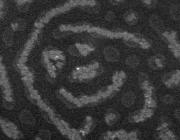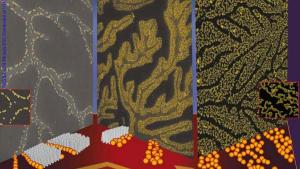Citation:
Shenhar, R. ; Sanyal, A. ; Uzun, O. ; Nakade, H. ; Rotello, V. M. Integration of recognition elements with macromolecular scaffolds: Effects on polymer self-assembly in the solid state. Macromolecules 2004, 37, 4931-4939.
Date Published:
JUN 29Abstract:
Polystyrene scaffolds were grafted with model functionalities featuring strongly interacting hydrogen bonding and aromatic stacking elements. Both glass transition temperatures and degree of microphase separation in functionalized block copolymers depend on the nature of the functionality and in particular on the strength of intermolecular interactions. The polymers under study were amorphous; it was found, however, that domain periodicities of functionalized diblock copolymers in the microphase-separated state are extremely sensitive to local interactions between functionalities and can express even subtle differences in interaction strength. The results emphasize the ability to fine-tune polymer microstructure and thermomechanical behavior using supramolecular chemistry.See also: Postdoc papers (2002-2005)





